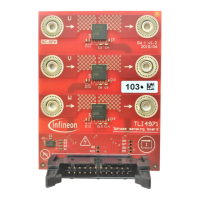7 Diagnosis Mode
General Description
The TLI4971 current sensor is equipped with an internal self-diagnosis mode. It can be enabled by setting bit 14
at address 0x51 to logical one.
In order to verify the full functionality of the device signal path and the external signal conditioning circuit the
diagnosis mode can be activated externally.
The diagnosis mode can be activated at any time after start up by forcing the OCD2 for at least 100µs to GND. The
programmed threshold limits for the OCD channels are modified during the diagnosis test is activated. It is
recommended to run the diagnosis mode as an initial test after startup.
The sensor converts the magnetic flux density to output voltage, which is linearly proportional to the current
through the sensor package. In diagnosis mode, an additional known test voltage will be add at the Hall probes
to the current depending output voltage.
The voltage caused by the test signal is equivalent to a primary current of 40A. The output voltage at A
OUT
is
dependent on the sensitivity range.
The threshold voltage of the OCD comparators is set to fixed values (V
TEST
x 1.2, V
TEST
x 0.8) as seen in
Figure 24.
How to Operate
Ensure the OCD2 are not pull together in a multiple sensor setup. If connect together and Diagnosis Mode is
enabled there will be interaction between the sensors: In an overcurrent event one sensor can trigger the
diagnosis of the other sensor. The diagnosis event of the other sensor will trigger the diagnosis of the first sensor.
A deadlock exist.
Force OCD2 to GND for at least 100µs to activate the diagnosis mode.
Observe the voltage on the A
OUT
and V
REF
pin according to the timing shown in Figure 24.
o The additional output voltage caused by the test mode corresponds to an input current of about
40A.
o The A
OUT
voltage will change accordingly to the set sensitivity range.
The current sensor operates in normal mode after 4 times 250 µs = 1 ms.
Recommendation
To avoid unintended activation, the minimum pulse width of the activation pulse applied at OCD2 has to meet
the minimum timing constraint of 100µs.
Since the OCD2 is kept to GND after startup by the sensor, the capacitance on the OCD2 pin shall be low to avoid
unintended activation of the diagnosis mode because of a to slow release of the OCD2 level. This can happen if
the threshold level for a logic “1” (1.6V) is not reached within 100µs.
If all OCD2 in a multiple current sensor system are connected together the OCD2 fault indication might activate
an unintended activation of the diagnosis mode by forcing the pin to ground due to an over current event.

